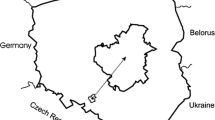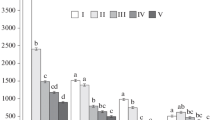Abstract
We studied the immediate changes in pre-treatment coarse woody debris (CWD) after retention felling and mechanical site preparation (scarification) in mature Picea abies-dominated boreal forest. Retention felling and scarification were hypothetised to affect the amount of CWD. The disturbance caused to CWD was assumed to depend on species and decay class. Logs were inventoried before fellings, after fellings, and after scarification, estimating the damage percentage for each log. After felling, 7.8% of the total pre-treatment volume of CWD was destroyed in the felled area. After scarification, the decline from pre-treatment volume was 67.6% in the felled area. The amount of CWD decreased also inside the retention tree groups; in the 1st post-treatment season, 4.6% was destroyed of the pre-treatment volume and 20% in the 2nd season. Of the retained trees, 40% were uprooted by the end of the 2nd season. If the majority of the initial downed CWD is destroyed by scarification, as our results show, we can estimate that since scarification became a widely used regeneration method in the 1960s, at least from 4 to 6 million m3 of CWD has already been destroyed in Finland. The role of CWD as a key element for biodiversity in boreal forest is generally accepted, which has led to retention of trees in fellings instead of clear felling. We suggest that at least as important as leaving trees in order to maintain continuum in CWD and species diversity is to preserve existing CWD in fellings over the regeneration phase. This can be done using less destructive harvesting methods, reduced use of scarification and placing retention tree groups in patches with high amounts of CWD.
Similar content being viewed by others
References
Andersson L.I. and Hytteborn H. 1991. Bryophytes and decaying wood: a comparison between managed and natural forest. Holarctic Ecology 14: 121–130.
Andrén H. 1994. Effects of habitat fragmentation on birds and mammals in landscapes with different populations of suitable habitat: a review. Oikos 71: 355–366.
Anonymous 1999. Finnish Forest Certification Project. Draft Finnish Forest Certification Standards. Helsinki, 82 pp.
Anonymous 2000a. Finnish Statistical Yearbook of Forestry 2000. Finnish Forest Research Institute, Gummerus Kirjapaino Oy, Jyväskylä, Finland, 366 pp.
Anonymous 2000b. Metsien suojelun tarve Etelä-Suomessa ja Pohjanmaalla. Etelä-Suomen ja Pohjanmaan metsien suojelun tarve -työryhmän mietintö. Ympäristöministeriö (Ministry of the Environment), Helsinki, Finland, p. 12.
Benson R.E. and Schlieter J.A. 1979. Woody material in northern Rocky Mountain forests: volume, characteristics, and changes with harvesting. In: Environmental Consequences of Timber Harvesting in Rocky Mountain Coniferous Forests. Symposium Proceedings. 11-13 September 1979, Missoula, Montana. USDA Forest Service General Technical Report INT-90, Ogden, Utah, pp. 27–36.
Esseen P.-A., Ehnström B., Ericsson L. and Sjöberg K. 1997. Boreal forests. In: Hansson L. (ed) Boreal Ecosystems and Landscapes: Structures, Processes and Conservation of Biodiversity. Ecological Bulletins 46: 16–47.
Franklin J.F., Berg D.R., Thornburgh D.A. and Tappeiner J.C. 1997. Alternative silvicultural approaches to timber harvesting: variable retention harvest systems. In: Kohn K.A. and Franklin J.F. (eds) Creating a Forestry for the 21st Century: The Science of Ecosystem Management. Island Press, Washington, DC, 475 pp.
Fridman J. and Walheim M. 2000. Amount, structure, and dynamics of dead wood on managed forestland in Sweden. Forest Ecology and Management 131: 23–36.
Hansen A.J., Spies T.A., Swanson F.J. and Ohmann J.L. 1991. Conserving biodiversity in managed forests. Bioscience 41: 382–392.
Harmon M.E., Franklin J.F., Swanson F.J., Sollins P., Gregory S.V., Lattin J.D., Andersson N.H., Cline S.P., Aumen N.G., Sedell J.R., Lienkaemper G.W., Cromack K. and Cummins K.W. 1986. Ecology of coarse woody debris in temperate ecosystems. Advances in Ecological Research 15: 133–302.
Hazell P., Kellner O., Rydin H. and Gustafsson L. 1998. Presence and abundance of four epiphytic bryophytes in relation to density of aspen (Populus tremula) and other stand characteristics. Forest Ecology and Management 107: 147–157.
Hylander K. 2000. Using bryophytes in evaluation of stream buffer strips in managed boreal forests. In: Karjalainen L. and Kuuluvainen T. (eds) Disturbance Dynamics in Boreal Forests. Restoration and Management of Biodiversity. Kuhmo, Finland, 21-25 August 2000, 23 pp.
Hämet-Ahti L., Suominen J., Ulvinen T. and Uotila P. (eds) 1998. Retkeilykasvio (Field Flora of Finland). 4th edn. Finnish Museum of Natural History, Botanical Museum, Helsinki, Finland, 656 pp.
Hörnberg G., Ohlson M. and Zackrisson O. 1995. Stand dynamics, regeneration patterns and long-term continuity in boreal old-growth Picea abies forests. Journal of Vegetation Science 6: 291–298.
Hörnberg G., Zackrisson O., Segerström U., Svensson B.W., Ohlson M. and Bradshaw R.H.W. 1998. Boreal swamp forests. Biodiversity ‘hotspots’ in an impoverished forest landscape. BioScience 48: 795–802.
Jalonen J. and Vanha-Majamaa I. 2001. Immediate effects of four different felling methods on mature boreal spruce forest understorey vegetation in southern Finland. Forest Ecology and Management 146: 25–34.
Kimmins J.P. 1997. Forest Ecology. A Foundation for Sustainable Management. 2nd edn. Prentice Hall, Upper Saddle River, New Jersey, 596 pp.
Krajick K. 2001. Defending deadwood. Science 293: 1579–1581.
Kramer P.J. and Kozlowski T.T. 1979. Physiology of Woody Plants.Academic Press Inc., New York, 811 pp.
Krankina O.N. and Harmon M.E. 1995. Dynamics of the dead wood carbon pool in northwestern Russian boreal forests. Water, Air and Soil Pollution 82: 227–238.
Kruys N., Fries C., Jonsson B.G., Lämås T. and Stål G. 1999. Wood-inhabiting cryptogams on dead Norway spruce (Picea abies) trees in managed Swedish boreal forests. Canadian Journal of Forest Research 29: 178–186.
Kuuluvainen T., Syrjänen K. and Kalliola R. 2001. Logs in a pristine Picea abies forest: occurrence, decay stage distribution and spatial pattern. Ecological Bulletins 49: 105-113.
Lee P.C., Crites S., Nietfeld M., Nguyen H. and Stelfox J.B. 1997. Characteristics and origins of deadwood material in aspen-dominated boreal forests. Ecological Applications 7: 691–701.
Lofroth E. 1998. The dead wood cycle. In: Voller J. and Harrison S. (eds) Conservation Biology Principles for Forested Landscapes. UBC Press, Vancouver, Canada, pp. 185–214.
Mattson K.G., Swank W.T. and Waide J.B. 1987. Decomposition of woody debris in a regenerating, clear-cut forest in the Southern Appalachians. Canadian Journal of Forest Research 17: 712–721.
McCarthy B.C. and Bailey R.R. 1994. Distribution and abundance of coarse woody debris in a managed forest landscape of the central Appalachians. Canadian Journal of Forest Research 24: 1317–1329.
McComb W. and Lindenmayer D. 1999. Dying, dead and down trees. In: Hunter M.L. Jr. (ed) Maintaining Biodiversity in Forest Ecosystem. Cambridge University Press, Cambridge, UK, pp. 335–372.
Naesset E. 1999. Decomposition rate constants of Picea abies logs in southeastern Norway. Canadian Journal of Forest Research 29: 372–381.
Ojala E., Mönkkönen M. and Inkeröinen J. 2000. Epiphytic bryophytes on European aspen Populus tremula in old-growth forests in northeastern Finland and in adjacent sites in Russia. Canadian Journal of Botany 78: 529–536.
Rassi P., Alanen A., Kanerva T. and Mannerkoski I. (eds) 2001. Suomen lajien uhanalaisuus 2000 (The 2000 Red List of Finnish Species). Ympäristöministeriö and Suomen Ympäristökeskus (Ministry of the Environment and Finnish Environment Institute), Helsinki, Finland.
Siitonen J. 2001. Forest management, coarse woody debris and saproxylic organisms: Fennoscandian boreal forests as an example. Ecological Bulletins 49: 11–41.
Siitonen J., Martikainen P., Punttila P. and Rauh J. 2000. Coarse woody debris and stand characteristics in mature managed and old-growth boreal mesic forests in southern Finland. Forest Ecology and Management 128: 211–225.
Sippola A.-L., Siitonen J. and Kallio R. 1998. Amount and quality of coarse woody debris in natural and managed coniferous forests near the timberline in Finnish Lapland. Scandinavian Journal of Forest Research 13: 204–214.
Spies T.A. and Franklin J.F. 1996. The diversity and maintenance of old-growth forests. In: Szaro R.C. and Johnston D.W. (eds) Biodiversity in Managed Landscapes. Theory and Practice. Oxford University Press, Oxford, UK.
Spies T.A., Franklin J.F. and Thomas T.B. 1988. Coarse woody debris in Douglas-fir forests of western Oregon and Washington. Ecology 69: 1689–1702.
Stanners D. and Bourdeau P. (eds) 1991. Europe's Environment. Human Activities. Forestry. The report of the state of the pan-European environment requested by the environmental ministers for the whole of Europe at the ministerial conference held at Dobiŕś Castle, Czechoslovakia, June 1991. European Environment Agency, Copenhagen, Denmark, pp. 464–478.
Stevens V. 1997. The ecological role of coarse woody debris: an overview of the ecological importance of CWD in B.C. forests. Working Paper 30/1997. Research Branch, B.C. Ministry of Forestry, Victoria, Canada
Ståhl G., Ringvall A. and Fridman J. 2001. Assessment of coarse woody debris - a methodological overview. Ecological Bulletins 49: 57–70.
Söderström L. 1987a. Dispersal as a limiting factor for distribution among epixylic bryophytes. Symposio Biologica Hungarica 35: 475–483.
Söderström L. 1987b. The occurrence of epixylic bryophyte and lichen species in an old natural and a managed forest stand in northeast Sweden. Biological Conservation 45: 170-178.
Söderström L. 1988. Sequence of bryophytes and lichens in relation to substrate variables of decaying coniferous wood in northern Sweden. Nordic Journal of Botany 8: 89–97.
Takahashi M., Sakai Y., Ootomo R. and Shiozaki M. 2000. Establishment of tree seedlings and watersoluble nutrients in coarse woody debris in an old-growth Picea abies forest in Hokkaido, northern Japan. Canadian Journal of Forest Research 30: 1148–1155.
Uliczka H. and Angelstam P. 1999. Occurrence of epiphytic macrolichens in relation to tree species and age in managed boreal forest. Ecography 22: 396–405.
Vanha-Majamaa I. and Jalonen J. 2001. Green tree retention in Fennoscandian forestry. Scandinavian Journal of Forest Research 3: 79–90.
Author information
Authors and Affiliations
Rights and permissions
About this article
Cite this article
Hautala, H., Jalonen, J., Laaka-Lindberg, S. et al. Impacts of retention felling on coarse woody debris (CWD) in mature boreal spruce forests in Finland. Biodiversity and Conservation 13, 1541–1554 (2004). https://doi.org/10.1023/B:BIOC.0000021327.43783.a9
Issue Date:
DOI: https://doi.org/10.1023/B:BIOC.0000021327.43783.a9




